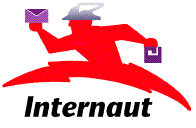
BBSNet
Brad Clements
Copyright (c) 1993, Brad Clements. All rights reserved. Reprinted by permission.
What is BBSNet?
BBSNet is a product from MurkWorks that provides real-time Internet connectivity for popular MSDOS based BBS software packages. Supported protocols include incoming access (from the Internet) via Telnet, as well as Telnet, FTP, Archie and Gopher access to the Internet for BBS users. BBSNet requires an Internet connection as well as Novell NetWare 386 v3.11. BBSNet does not currently support electronic mail but SMTP (both client and server) is expected to be available in the first quarter of 1994. RIP support for the Archie/FTP and Gopher clients will be added after the first release if it is not included in the first release.
BBSNet supports PCBoard (/M version required for incoming Telnet), The Major BBS (advanced LAN option required for incoming Telnet), WildCat!IM (Version 4 required for incoming Telnet access), Searchlight, TurBoard and other FOSSIL compatible BBSes. TBBS (with Interchange) may be supported in a later release.
BBSes running on top of a FOSSIL driver can support incoming Telnet access; systems that can execute a DOS door, and provide a FOSSIL interface to an async port, can support dial-up telnet, FTP/Archie and Gopher. Client access for Major BBS works as an Add-on DLL, rather than as a DOS door.
The first release of BBSNet operates as a series of NetWare Loadable Modules (NLMs). As a result, a Novell NetWare 386 v3.11 file server is required. Often a five user version of NetWare 386 is sufficient, depending on the number of nodes you have; the cost of such a version is roughly $400 mail order. Novell version 3.12 should also work, but versions 4.0 and 4.01 are not currently supported. Since BBSNet uses the TCP/IP stack included in NetWare 386, neither Lantastic nor NetWare LITE are supported. Either DESQview or OS/2 may be used to run multiple copies of your BBS.
How does BBSNet work?
When a remote user first initiates a connection to the BBS, the BBSNet NLMs search the Local Ethernet to find the first physical node with an open port. After the user is connected to an open port, the BBSNet NLMs process the Telnet connection and retransmit the users keystrokes on the local Ethernet via the SPX protocol to the BBS node to which the remote user is attached.
For example, say we have two PCs, each running DESQview with four copies of PCBoard running on each machine. On receiving an incoming Telnet connection, BBSNet will query the first PC to see if one of the four PCBoard copies is free. If not, then BBSNet will query the second PC. The process continues until all PCs have been queried or until a free virtual node has been found. If no nodes are free, the remote Telnet user is asked to call back later.
For dial-in BBS users looking to get out, a custom DOS Door communicates with the NetWare server. The BBSNet NLMs on the NetWare server then convert the users SPX packets into Telnet, FTP, Archie or Gopher requests and send them out to the Internet using TCP/IP.

Typical BBSNet setup
Capacity planning
A modem dialup link should be able to support up to four or five Telnet users (either incoming or outgoing) so long as they are not transferring files. However, as soon as a user begins a file transfer (either over the Telnet connection or via FTP), the response time for the other users will become intolerable. As a result, if you intend to allow file transfers, you will need to purchase a 56 K or faster link.
If your file transfer traffic is primarily traffic going from sites on the Internet to your BBS (rather than from your BBS out to sites on the Internet), then you may wish to consider a 10 Mbps Cable Internet hookup. These hookups are extremely economical, but since they are comprised of a 10 Mbps IN channel, and only a 14.4 Kbps OUT channel, they cannot support extensive data flows from the BBS out to the network.
Features of BBSNet
Incoming Telnet
By providing incoming Telnet access, a BBS becomes accessible to the Internet user base, estimated at 20 million (1993), and growing at an annual rate of 100 percent. Users who Telnet into your BBS access it in the same manner as regular dialup users. File transfers can take place through the Telnet connection if the users terminal server is properly configured. Users coming from networked UNIX systems can also use the File Transfer Protocol (FTP) to download files from or upload files to the BBS.
Outgoing Telnet
Via a door program, BBSNet allows dialup users to Telnet to other hosts on the Internet, allowing the BBS to function as a terminal server for local callers. Callers execute a telnet door in order to access the Telnet client software., then enter the domain name of the remote host, or select from a list of popular sites which can be configured by the sysop.
FTP/Archie
BBSNet provides a combined FTP/Archie client for dialup users. Callers may FTP directly to a remote host, or use the Archie client to locate a file. Once found, Archie instructs the FTP client where to locate the file and automatically retrieves it. The selected file is returned to the BBS and downloaded to the caller using the transfer method selected by the user. Callers may also upload files to the BBS, then use the FTP client to transfer them to a remote host.
Gopher
BBSNet includes a gopher client application which can display retrieved information on the screen or save it in a file for downloading at the end of a session.
Brad Clements, bkc@murkworks.com, last modified: 1/18/94


















